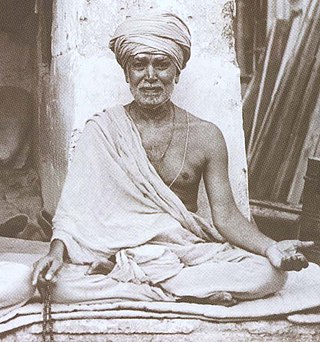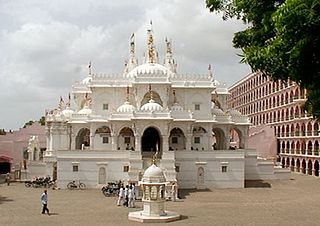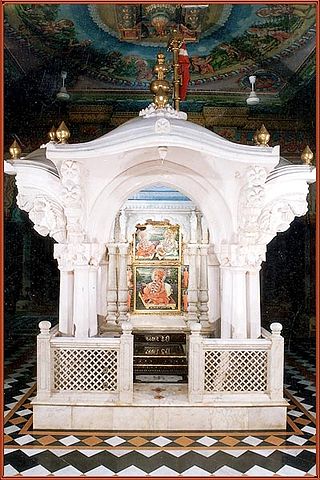
Bochasanwasi Akshar Purushottam Swaminarayan Sanstha is a Hindu denomination within the Swaminarayan Sampradaya. It was formed in 1905 by Yagnapurushdas following his conviction that Swaminarayan remained present on earth through a lineage of gurus starting with Gunatitanand Swami.

Swaminarayan, also known as Sahajanand Swami, was a yogi and ascetic, who is believed by followers to be a manifestation of Krishna, or as the highest manifestation of Purushottam, and around whom the Swaminarayan Sampradaya developed.

Gunatitanand Swami, born Mulji Jani, was a prominent paramhansa of the Swaminarayan Sampradaya who was ordained by Swaminarayan and is accepted as the first spiritual successor of Swaminarayan by the Bochasanwasi Akshar Purushottam Swaminarayan Sanstha (BAPS). Born into a religious family in the small farming community of Bhadra in Gujarat, India, he first received religious education under his father's guru, Ramanand Swami before encountering Swaminarayan and becoming a swami under him at the age of 25. He was revered for his spiritual discourses and divine service

Muktanand Swami (1758–1830), born Mukunddas, was a swami and paramahansa of the Swaminarayan Sampradaya.

Gopalanand Swami (1781–1852) was a paramhansa of the Swaminarayan Sampradaya who was ordained by Swaminarayan. He worked and guided many followers to spread the Swaminarayan Sampradaya. The Swaminarayan Sampradaya believes that Gopalanand Swami is regarded as one of the yogis who attained the positions of Ashthangyog or the 8 fold paths in the field of sacred yog. It is also believed that Gopalanand Swami was appointed as the head of both Vadtal and Amdavaad Desh.

The Vachanamrut is a sacred Hindu text consisting of 273 religious discourses delivered by Swaminarayan from 1819 to 1829 CE and is considered the principal theological text within the Swaminarayan Sampradaya. Compiled by four of his senior disciples, Swaminarayan edited and approved the scripture. As followers believe Swaminarayan to be Parabrahman, or God, the Vachanamrut is considered a direct revelation from God and thus the most precise interpretation of the Upanishads, Bhagavad Gita, and other important Hindu scriptures.

Shastriji Maharaj, born Dungar Patel and ordained Shastri Yagnapurushdas, was a swami of the Swaminarayan Sampradaya and founder of the Bochasanwasi Akshar Purushottam Swaminarayan Sanstha (BAPS). Several branches accept him as the third spiritual successor of Swaminarayan in the lineage of Aksharbrahma Gurus through whom Swaminarayan manifests, which began with Gunatitanand Swami. Born in a family of farmers in central Gujarat, India, he became a swami within the Vadtal diocese of the Swaminarayan Sampradaya at the age of 17 where he was given the name Yagnapurushdas Swami. The prefix Shastri was later added in recognition of his eminent scholarship in Sanskrit and the Hindu scriptures. He established BAPS after a doctrinal split from the Vadtal diocese of the Swaminarayan Sampradaya.

Shri Swaminarayan Mandir, Junagadh, also called ShriRadha Ramana Temple, Junagadh is a Hindu temple in Junagadh, Gujarat, India. This temple was ordered to be built by Swaminarayan himself, the founder of the Swaminarayan Sampradaya.

Shri Swaminarayan Mandir, Bhuj is a Hindu temple in Bhuj. This temple was constructed by Swaminarayan, founder of the Swaminarayan Sampradaya.

Swaminarayan Mandir, Gadhada, also known as Gopinathji Dev mandir, is a Hindu temple in Gadhada, Gujarat, India. This Swaminarayan Sampradaya temple is one of the six temples built by the sect's founder Swaminarayan.

Ramanand Swami to a Brahmin family in Ayodhya in Vikram Samvat 1795. His parents were Ajay Sharma (father) and Sumati (mother). He was considered to be the incarnation of Uddhava, a close friend of Krishna. Ramanand was the founder and head of the Uddhav Sampraday. Ramanand Swami adopted the Vishishtadvaita doctrine of the Vaishnava which was first propounded by Ramanuja several centuries earlier. In his travels to Srirangam in southern India in his early life, Ramanand Swami said that Ramanuja gave him diksha (initiation) in a dream and appointed him in his line as an acharya. Ramanand Swami then travelled West to Saurastra to spread the philosophy of Ramanuja. Before dying in 1858, Ramanand Swami passed the reins of the Uddhav Sampraday to Swaminarayan.
A shikharbaddha mandir is a traditional Hindu or Jain place of worship, typically featuring architecture characterized by superstructures with towers pinnacles and domes and often built of carved marble, sandstone, or other stone. While such mandirs are common in many branches of Hinduism, the use of the term shikharbaddha mandir to describe such mandirs is most common in the Swaminarayan branch of Hinduism as well as Jainism. The opposite of the shikharbaddha temple is one without a shikhara tower, i.e. with a flat roof.
According to the Swaminarayan Hindu philosophy, a Dev Mandir is a Hindu temple where pictorial images of deities are installed.
The Desh Vibhag Lekh is an Indian document written by Swaminarayan in 1827 establishing the division of the Swaminarayan Sampradaya into two dioceses by territory of Ahmedabad and Vadtal. This document is highly regarded by the two diocese as it establishes Acharyas as the successors to Swaminarayan. Groups that regard sadhus over acharyas downplay the importance of the Lekh as an administrative document.

The Swaminarayan Sampradaya, also known as Swaminarayan Hinduism and Swaminarayan movement, is a Hindu Vaishnava sampradaya rooted in Ramanuja's Vishishtadvaita, characterized by the worship of its charismatic founder Sahajanand Swami, better known as Swaminarayan (1781–1830), as an avatar of Krishna or as the highest manifestation of Purushottam, the supreme God. According to the tradition's lore, both the religious group and Sahajanand Swami became known as Swaminarayan after the Swaminarayan mantra, which is a compound of two Sanskrit words, swami and Narayan.

The Swamini Vato is a set of quotations and sayings written by Gunatitanand Swami. It is a scripture in the Swaminarayan denomination of the Hindu religion. It was documented in the mid 19th century over the course of Gunatitanand Swami's 40 year tenure as the Mahant of Junagadh Mandir.
Bhagatji Maharaj, born as Pragji Bhakta, was a householder devotee in the Swaminarayan Sampradaya, a Hindu denomination. He is regarded as the second spiritual successor of Swaminarayan in the Bochasanwasi Akshar Purushottam Swaminarayan Sanstha (BAPS).

The Akshar Deri is a major site of pilgrimage in the Swaminarayan Sampradaya and is located in the rang mandap of the BAPS Swaminarayan temple in Gondal, India. The structure marks the cremation site and serves as a memorial to Gunatitanand Swami. An event was held to commemorate 150 years of the structure in Gondal, the structure as well as the site was renovated to bring it to modern standards.

Mahant Swami Maharaj is the present guru and president of the Bochasanwasi Akshar Purushottam Swaminarayan Sanstha (BAPS), a major branch of the Swaminarayan Sampradaya, a Hindu denomination. BAPS regards him as the sixth spiritual successor of Swaminarayan, following Gunatitanand Swami, Bhagatji Maharaj, Shastriji Maharaj, Yogiji Maharaj, and Pramukh Swami Maharaj. He is believed by his followers to be in constant communion with Bhagwan Swaminarayan, and ontologically, the manifestation of Akshar, the perfect devotee of God.
















